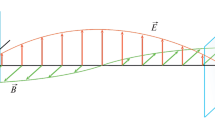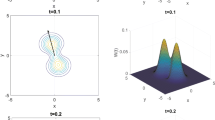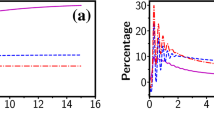Abstract
The paper studies resonant generation of higher-order harmonics in a closed cavity in Euler-Heisenberg electrodynamics from the point of view of pure quantum field theory. We consider quantum states of the electromagnetic field in a rectangular cavity with conducting boundary conditions and calculate the cross section for the merging of three quanta of cavity modes into a single one (\(3 \rightarrow 1\) process) as well as the scattering of two cavity mode quanta (\(2 \rightarrow 2\) process). We show that the amplitude of the merging process vanishes for a cavity with an arbitrary aspect ratio and provide an explanation based on plane wave decomposition for cavity modes. Contrary, the scattering amplitude is nonzero for specific cavity aspect ratio. This \(2 \rightarrow 2\) scattering is a crucial elementary process for the generation of a quantum of a high-order harmonics with frequency \(2\omega _1 - \omega _2\) in an interaction of two coherent states of cavity modes with frequencies \(\omega _1\) and \(\omega _2\). For this process, we calculate the mean number of quanta in the final state in a model with dissipation, which supports the previous result of resonant higher-order harmonics generation in an effective field theory approach (Kopchinskii and Satunin in Phys Rev A 105:013508, 2022).
Graphical abstract

Similar content being viewed by others
Data Availability Statement
This manuscript has no associated data or the data will not be deposited. [Authors’ comment: There is no special associated data since the article is pure theoretical. Details of the calculations are given in Appendices A and B.]
Notes
The idea was proposed in [35].
Natural system of units \(\hbar =c=1\) is assumed.
Here, n is a single integer in case of a single closed dimension, and a set of integers in case of more closed dimensions.
Both the third harmonics generation (\(n'=n, p'=p, q'=q\)) and the generation for a mode of combined frequency \(2\omega _1 + \omega _2\) are considered.
In general, one should take into account many-particle states of the signal mode as well.
References
I. Kopchinskii, P. Satunin, Resonant generation of electromagnetic modes in nonlinear electrodynamics: classical approach. Phys. Rev. A 105, 013508 (2022)
H. Euler, B. Kockel, The scattering of light by light in Dirac’s theory. Naturwiss. 23(15), 246–247 (1935)
W. Heisenberg, H. Euler, Consequences of Dirac’s theory of positrons. Z. Phys. 98(11–12), 714–732 (1936)
A.A. Anselm, Axion \(\leftrightarrow \) photon oscillations in a steady magnetic field. (In Russian). Yad. Fiz. 42, 1480–1483 (1985)
L. Maiani, R. Petronzio, E. Zavattini, Effects of nearly massless, spin zero particles on light propagation in a magnetic field. Phys. Lett. B 175, 359–363 (1986)
S. Evans, J. Rafelski, Virtual axion-like particle complement to Euler-Heisenberg-Schwinger action. Phys. Lett. B 791, 331–334 (2019)
G.V. Dunne, The Heisenberg-Euler effective action: 75 years on. Int. J. Mod. Phys. A 27, 1260004 (2012)
W. Dittrich, H. Gies, Springer Tracts in Modern Physics, vol. 166 (Springer, Berlin, Heidelberg, 2000)
A. Kuznetsov, N. Mikheev, Springer Tracts in Modern Physics, vol. 252 (Springer, Berlin, Heidelberg, 2013)
A. Fedotov, A. Ilderton, F. Karbstein, B. King, D. Seipt, H. Taya, G. Torgrimsson, Advances in QED with intense background fields. Phys. Rept. 1010, 1–138 (2023)
R. Baier, P. Breitenlohner, Photon propagation in external fields. Acta Phys. Austriaca 25, 212–223 (1967)
Z. Bialynicka-Birula, I. Bialynicki-Birula, Nonlinear effects in Quantum Electrodynamics. Photon propagation and photon splitting in an external field. Phys. Rev. D 2, 2341–2345 (1970)
N.N. Rozanov, Four-wave interactions of intense radiation in vacuum. JETP 76, 991 (1993)
CoReLS. https://corels.ibs.re.kr/
E. Lundström, G. Brodin, J. Lundin, M. Marklund, R. Bingham, J. Collier, J.T. Mendonça, P. Norreys, Using high-power lasers for detection of elastic photon-photon scattering. Phys. Rev. Lett. 96, 083602 (2006)
H. Gies, F. Karbstein, C. Kohlfürst, N. Seegert, Photon-photon scattering at the high-intensity frontier. Phys. Rev. D 97, 076002 (2018)
B. King, H. Hu, B. Shen, Three-pulse photon-photon scattering. Phys. Rev. A 98, 023817 (2018)
A.M. Fedotov, N.B. Narozhny, Generation of harmonics by a focused laser beam in vacuum. Phys. Lett. A 362, 1–5 (2007)
P.V. Sasorov, F. Pegoraro, T.Z. Esirkepov, S.V. Bulanov, Generation of high order harmonics in Heisenberg-Euler electrodynamics. New J. Phys. 23(10), 105003 (2021)
C. Sundqvist, F. Karbstein, Two-beam laser photon merging. Phys. Rev. D 108(5), 056028 (2023)
A. Di Piazza, K.Z. Hatsagortsyan, C.H. Keitel, Harmonic generation from laser-driven vacuum. Phys. Rev. D 72, 085005 (2005)
F. Karbstein, R. Shaisultanov, Stimulated photon emission from the vacuum. Phys. Rev. D 91(11), 113002 (2015)
H. Gies, F. Karbstein, C. Kohlfürst, All-optical signatures of Strong-Field QED in the vacuum emission picture. Phys. Rev. D 97(3), 036022 (2018)
I.A. Aleksandrov, G. Plunien, V.M. Shabaev, Photon emission in strong fields beyond the locally-constant field approximation. Phys. Rev. D 100(11), 116003 (2019)
I.A. Aleksandrov, A.D. Panferov, S.A. Smolyansky, Radiation signal accompanying the Schwinger effect. Phys. Rev. A 103(5), 053107 (2021)
I.A. Aleksandrov, A. Di Piazza, G. Plunien, V.M. Shabaev, Stimulated vacuum emission and photon absorption in strong electromagnetic fields. Phys. Rev. D 105(11), 116005 (2022)
G. Brodin, M. Marklund, L. Stenflo, Proposal for detection of QED vacuum nonlinearities in Maxwell’s equations by the use of waveguides. Phys. Rev. Lett. 87, 171801 (2001)
D. Eriksson, G. Brodin, M. Marklund, L. Stenflo, A Possibility to measure elastic photon-photon scattering in vacuum. Phys. Rev. A 70, 013808 (2004)
Z. Bogorad, A. Hook, Y. Kahn, Y. Soreq, Probing axionlike particles and the axiverse with superconducting radio-frequency cavities. Phys. Rev. Lett. 123(2), 021801 (2019)
Y. Kahn, B. Giaccone, A. Lunin, A. Netepenko, R. Pilipenko, M. Wentzel, Searching for axions and light-by-light scattering with superconducting RF cavities. Proc. SPIE Int. Soc. Opt. Eng. 12016, 29 (2022)
B. Giaccone, et al., Design of axion and axion dark matter searches based on ultra high Q SRF cavities. 7 (2022). arXiv preprint, arXiv:2207.11346
K. Shibata, Intrinsic resonant enhancement of light by nonlinear vacuum. Eur. Phys. J. D 74(10), 215 (2020)
I. Kopchinskii, P. Satunin, Resonant generation of high-order harmonics in nonlinear electrodynamics. Phys. Part. Nucl. Lett. 20(3), 447–451 (2023)
S. Hacian, R. Jauregui, F. Soto, C. Villarreal, Spectrum of electromagnetic fluctuations in the Casimir effect. J. Phys. A 23, 2401–2412 (1990)
S. Hacyan, R. Jauregui, C. Villarreal, Spectrum of quantum electromagnetic fluctuations in rectangular cavities. Phys. Rev. A 47, 4204–4211 (1993)
S. Chenarani, A. Shirzad, Quantization in finite volumes using symplectic quantization programm. 11 (2013). arXiv preprint, arXiv:1311.0361
D. Hill, Electromagnetic fields in cavities: deterministic and statistical theories. Antennas Propag. Mag., IEEE 56, 306–306 (2014)
M.D. Schwartz, Cambridge University Press, 3 (2014)
H. Padamsee, Calculations for breakdown induced by “large defects’’ in superconducting niobium cavities. IEEE Trans. Magn. 19(3), 1322–1325 (1983)
D.A. Trunin, Enhancement of particle creation in nonlinear resonant cavities. Phys. Rev. D 107(6), 065004 (2023)
Acknowledgements
The authors thank Maxim Fitkevich, Dmitry Kirpichnikov, Dmitry Levkov, Valery Rubakov, Alexey Rubtsov and Dmitry Salnikov for helpful discussions. The work is supported by RSF grant 21-72-10151.
Author information
Authors and Affiliations
Contributions
All authors contributed equally to the paper
Corresponding author
Appendices
Elements of calculation of the matrix element for the \(3 \rightarrow 1\) merging process
In this Appendix, we provide more details for the merging matrix element calculation (12), whose expansion into the components of electromagnetic field strength operators has the following form,
Here, the brackets for the field strength operators are defined in the first line of (34). In total, 13 terms appear in Eq. (34). Let us present an evaluation for one of them:
Here, 4! is a combinatorial factor arising due to the identity of four \(E_y\) operators. At the last step we use \(\omega _n=k_n=\frac{\pi n}{L_x}\) and the similar relation for the 3n subscript.
Details of the matrix element \(2 \rightarrow 2\) calculation
Let us present the calculation for the terms of the matrix element (19) in more detail. The first term \(\langle ({\textbf {E}} {\textbf {E}} )^2\rangle \) reads,
Here, 8 and 2 are combinatorial coefficients, for shortness we indicate the result of integration with underbraces. Thus, the second term in (35) vanishes.
Analogically, the following term \(\langle ({\textbf {B}} {\textbf {B}} )^2\rangle \) reads,
The combinatorial coefficients 8 and 2 coincide with the previous case. However, the result of the integration differs. The first of the mixed terms \(\langle ({\textbf {B}} {\textbf {B}} ) ({\textbf {E}} {\textbf {E}} )\rangle \) reads,
The last term,
Finally, restoring the coefficient \(4\kappa \), the result (20)–(22) is obtained.
Rights and permissions
Springer Nature or its licensor (e.g. a society or other partner) holds exclusive rights to this article under a publishing agreement with the author(s) or other rightsholder(s); author self-archiving of the accepted manuscript version of this article is solely governed by the terms of such publishing agreement and applicable law.
About this article
Cite this article
Kopchinskii, I., Satunin, P. Resonant generation of electromagnetic modes in nonlinear electrodynamics: quantum perturbative approach. Eur. Phys. J. D 78, 54 (2024). https://doi.org/10.1140/epjd/s10053-024-00850-6
Received:
Accepted:
Published:
DOI: https://doi.org/10.1140/epjd/s10053-024-00850-6




